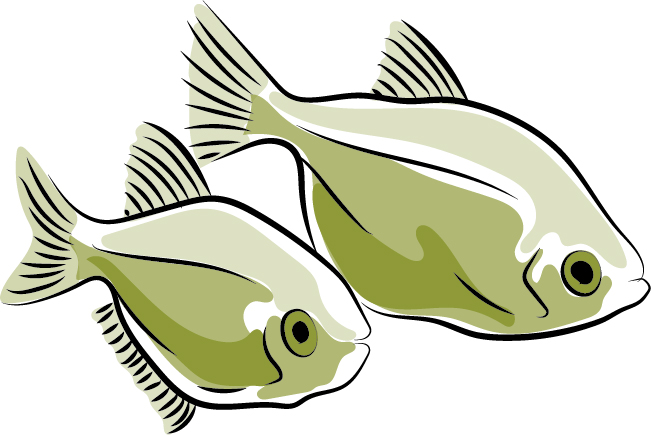Features:
- Weighs 850 pounds
- Contains seventy-five gallons of New York City tap water, ideal for fish because of its neutral pH, low mineral content, and minimal treatment
- Holds up to seventy-five inches of fish, or one inch of fish per gallon of water
- Often installed in dental office waiting rooms for its calming effect
When my dad moved into a two-bedroom apartment on the West Side of Manhattan, just a few blocks from where I lived with my mom and younger brother, he took his freshwater aquarium with him. My dad is an architect, but as a very young child I imagined that his true vocation was a caretaker for the aquarium. During the odd Saturdays I spent with him, we went on excursions to dimly lit Chinatown stores, where we squeezed through narrow aisles perilously crammed with display tanks, and paid repeat visits to the American Museum of Natural History’s Milstein Hall of Ocean Life, where a blue whale swims in suspension from the ceiling. I’d return home laden with chocolate, Pokémon cards, and plastic baggies of fish, separated by species, which my dad would set afloat on the surface of the aquarium, releasing them only once he was satisfied they’d acclimated. After consulting the back issues of Tropical Fish Hobbyist magazine archived in his bathroom, he would call our new houseguests by their Latin names: Carnegiella strigata, Pterophyllum altum, Danio margaritatus.
The fish tank was made entirely of glass and set on a steel frame. It held seventy-five gallons of tap water filtered through an external canister, and was loaded with one hundred pounds of fine gravel—micro-pebbles in shades of slate dotted with blue and pink. Within these walls my dad created an ecosystem unlike any found on earth. For flora he installed java fern, Amazon swords, and Madagascar lace plants—long, leafy green plants from three continents that lent the appearance of an underwater vegetable garden—as well as duckweed, which floated on the surface, just kissing the air. He sourced the fish from blackwater environments, which are tributaries of large river systems like the Irrawaddy or the Mekong. The tank held Congo tetras, emerald-eye Rasboras, silver angelfish, double-red cockatoo dwarf cichlids, blue rams, spotted Badis, and celestial pearl danios, among others, each species occupying its own place within the tank. The kuhli loaches, thin and striped like living tire marks, would zigzag along the bottom; the male guppies flaunted silk-scarf tails as they traveled across the middle; the chocolate gourami—timid mouthbrooders—would hide in the vegetation near the top.
In the new living room where my brother and I spent every other weekend, the only competition with the tank for our attention was the television, on which we watched and rewatched aquatic-themed movies: Titanic, A Fish Called Wanda, Captains Courageous, Cocoon. Gazing into the tank, however, was more mesmerizing than the screen: with no script, the stories that took shape were purely of my own invention. (Years later, while staring at the blank page before it filled with words, I would recall the tank’s limitless vista.) At night, after my dad put my brother and me to sleep, he’d sometimes doze off in front of the aquarium in a knockoff Bertoia diamond lounge chair, his face illuminated by a lavender fluorescent glow.
I was a shy, dreamy kid who liked to either destroy things or allow them to lapse into chaos (case in point: the kiddie tank my dad installed for me next to his behemoth, which he promptly repurposed as an arena for his breeding experiments). I had a habit of writing poems on scraps of paper, then eating them. I had trouble making friends. These qualities of mine weren’t paternally inherited, it was clear. My dad has always been a constructive person, a builder. At eight years old he became the youngest member of the Greater Atlanta Aquarium Society, and entered a starter ten-gallon tank in an annual aquarium show held downtown at Rich’s department store. As a teacher at Parsons School of Design, he required his students to read chapter 60 of his favorite book, Moby-Dick, in which, as in many of the novel’s chapters, an object is exhaustively described until its story emerges (whaling line, in this case). My dad is a man of many passions: not only freshwater aquariums but gardens, musicals, eclipses, fancy desserts. I could always intuit and understand the drive of his curiosity, but the intricacy of the fish tank baffled me. While my obsessions meandered nowhere or burned out fast, my dad was busy creating and sustaining a living ecosystem within our own living room.
Then my internal weather began to shift, the clouds parted, and I grew up. Last year I decided to revisit the world of the tank. I accompanied my dad to the Brooklyn Aquarium Society’s semiannual Giant Auction, which convened in Coney Island, at the New York Aquarium. In the shadow of the Cyclone roller coaster, I waded with my dad through a crowd of middle-aged fish enthusiasts. My dad bid high on a tiny catfish, and won. When I asked if the price was worth it, he replied that it was not, but that he was delighted all the same. Ever since I was a kid watching the aquarium’s undaunted life unfold, I have learned from him to sense the thrills that emanate from small things: the tiny details, odd moments, singular connections that build over time to a larger joy. Even just waiting around, observing the scene, I felt like a winner too.





